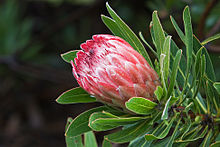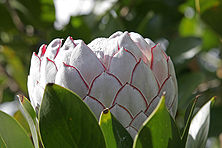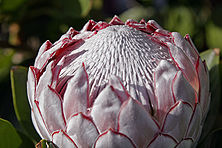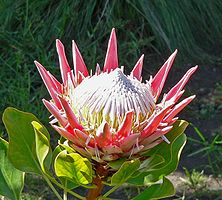- Protea
-
Protea 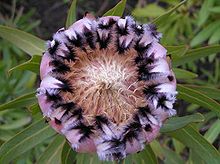
Protea lepidocarpodendron x neriifolia Scientific classification Kingdom: Plantae (unranked): Angiosperms (unranked): Eudicots Order: Proteales Family: Proteaceae Subfamily: Proteoideae Genus: Protea
L.Species See text
Protea (
 /ˈproʊtiːə/)[1] is both the botanical name and the English common name of a genus of flowering plants, sometimes also called sugarbushes.
/ˈproʊtiːə/)[1] is both the botanical name and the English common name of a genus of flowering plants, sometimes also called sugarbushes.Contents
Etymology
The genus Protea was named in 1735 by Carl Linnaeus after the Greek god Proteus, who could change his form at will, because proteas have such a wide variety of forms. Linnaeus's genus was formed by merging a number of genera previously published by Herman Boerhaave, although precisely which of Boerhaave's genera were included in Linnaeus's Protea varied with each of Linnaeus's publications.
Taxonomy
The Proteaceae family to which proteas belong is an ancient one. Its ancestors grew in Gondwanaland, 300 million years ago. Proteaceae is divided into two subfamilies: the Proteoideae, best represented in southern Africa, and the Grevilleoideae, concentrated in Australia and South America and the other smaller segments of Gondwanaland that are now part of eastern Asia. Africa shares only one genus with Madagascar, whereas South America and Australia share many common genera — this indicates they separated from Africa before they separated from each other.
Distribution
Most protea occur south of the Limpopo River. However, Protea kilimanjaro is found in the chaparral zone of Mount Kenya National Park. 92% of the species occur only in the Cape Floristic Region, a narrow belt of mountainous coastal land from Clanwilliam to Grahamstown, South Africa. The extraordinary richness and diversity of species characteristic of the Cape Flora is thought to be caused in part by the diverse landscape where populations can become isolated from each other and in time develop into separate species.
Botanical History
Proteas attracted the attention of botanists visiting the Cape of Good Hope in the 17th century. Many species were introduced to Europe in the 18th century, enjoying a unique popularity at the time amongst botanists.
Classification
Within the huge family Proteaceae, they are a member of the subfamily Proteoideae, which has Southern African and Australian members.
Species
(listed by section: a section has a name in two parts, consisting of the genus name and an epithet).
- Protea section Leiocephalae
- Protea caffra (Common Protea)
- Protea dracomontana
- Protea glabra
- Protea inopina
- Protea nitida (The Wagon Tree)
- Protea nubigena
- Protea parvula
- Protea petiolaris
- Protea rupicola
- Protea simplex
- Protea section Paludosae
- Protea enervis
- Protea section Patentiflorae
- Protea angolensis
- Protea comptonii
- Protea curvata
- Protea laetans
- Protea madiensis
- Protea rubropilosa
- Protea rupestris
- Protea section Lasiocephalae
- Protea section Cristatae
- Protea asymmetrica
- Protea wentzeliana
- Protea section Cynaroidae
- Protea cynaroides (King Protea)
- Protea section Paracynaroides
- Protea cryophila (Snow Protea)
- Protea pruinosa
- Protea scabriuscula
- Protea scolopendriifolia
- Protea section Ligulatae
- Protea burchellii
- Protea compacta
- Protea eximia
- Protea longifolia
- Protea obtusifolia
- Protea pudens
- Protea roupelliae
- Protea susannae
- Protea section Melliferae
- Protea aristata
- Protea lanceolata
- Protea repens (Common Sugarbush Protea)
- Protea section Speciosae
- Protea coronata
- Protea grandiceps
- Protea holosericea
- Protea laurifolia
- Protea lepidocarpodendron
- Protea lorifolia
- Protea magnifica
- Protea neriifolia (Oleander-leaf Protea)
- Protea speciosa
- Protea stokoei
- Protea section Exsertae
- Protea aurea
- Protea lacticolor
- Protea mundii
- Protea punctata
- Protea subvestita
- Protea venusta
- Protea section Microgeantae
- Protea acaulos
- Protea convexa
- Protea laevis
- Protea revoluta
- Protea ungustata
- Protea section Crinitae
- Protea foliosa
- Protea intonsa
- Protea montana
- Protea tenax
- Protea vogtsiae
- Protea section Pinifolia
- Protea acuminata
- Protea canaliculata
- Protea nana
- Protea pityphylla
- Protea scolymocephala
- Protea witzenbergiana
- Protea section Craterifolia
- Protea effusa
- Protea namaquana
- Protea pendula
- Protea recondita
- Protea sulphurea
- Protea section Obvallatae
- Protea caespitosa
- Protea section Subacaules
- Protea aspera
- Protea denticulata
- Protea lorea
- Protea piscina
- Protea restionifolia
- Protea scabra
- Protea scorzonerifolia
National symbol
Together with the springbok antelope, the protea had been treated as a sometimes controversial national symbol in South Africa, both during and after apartheid.
Today the South Africa national cricket team is known as "The Proteas" and this has linked the flower to wider nationalist sentiments in South Africa.
The former South African Prime Minister and architect of apartheid, Hendrik Frensch Verwoerd, had a dream to change the flag of South Africa to have in its center a leaping springbok antelope over a wreath of six proteas. This proposal, however, aroused too much controversy to be implemented.[citation needed]
After the demise of apartheid, the ANC government decreed that South African sporting teams, hitherto called "Springboks" were to be known as the "Proteas", although an exemption was made for the rugby union team, who remain "Springboks". In apartheid times, the "Proteas" was the Cape Coloured representative team.[2]
References
- ^ "Protea". Oxford English Dictionary. Oxford University Press. 2nd ed. 1989.
Sunset Western Garden Book, 1995:606–607 - ^ Today the national cricket team are known as "The Proteas". Grundlingh, A. M.; André Odendaal, S. B. Spies (1995). Beyond the Tryline: Rugby and South African Society. Ravan Press. p. 92. ISBN 0869754572.
External links
- Protea Atlas Project: a project to map the distribution of South African plant species, using Protea as a flagship.
- www.ncbi.nlm.nih.gov/Taxonomy/Browser
- [1] Pollack Group:leader in distribution of proteas in the world]
Categories:- Protea
- Proteaceae genera
- Protea section Leiocephalae
Wikimedia Foundation. 2010.

